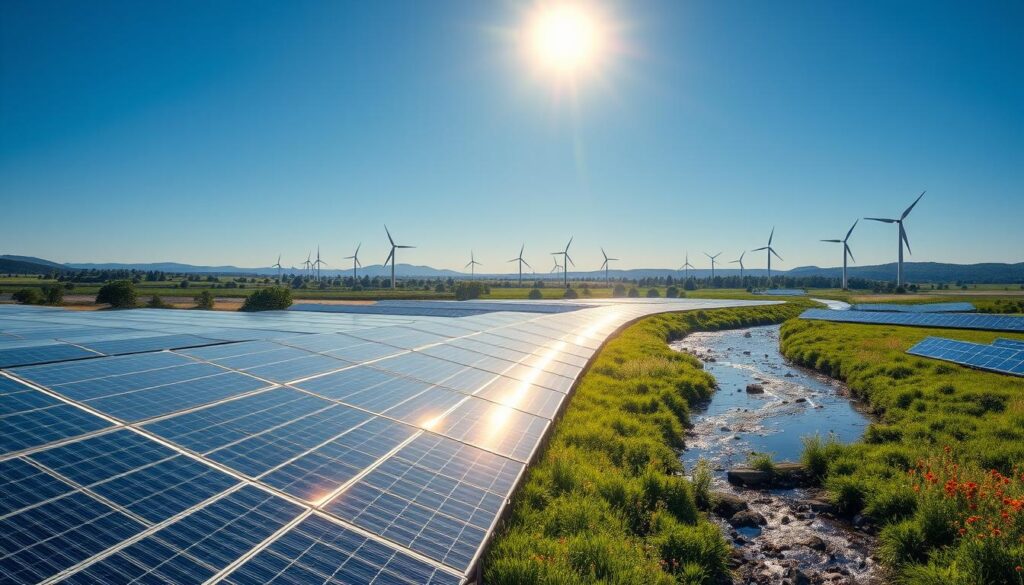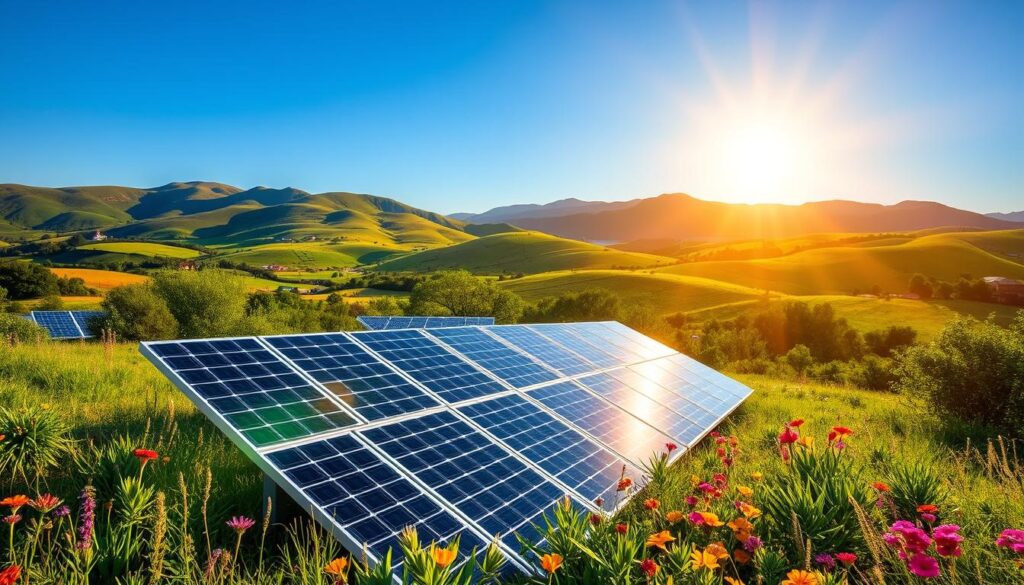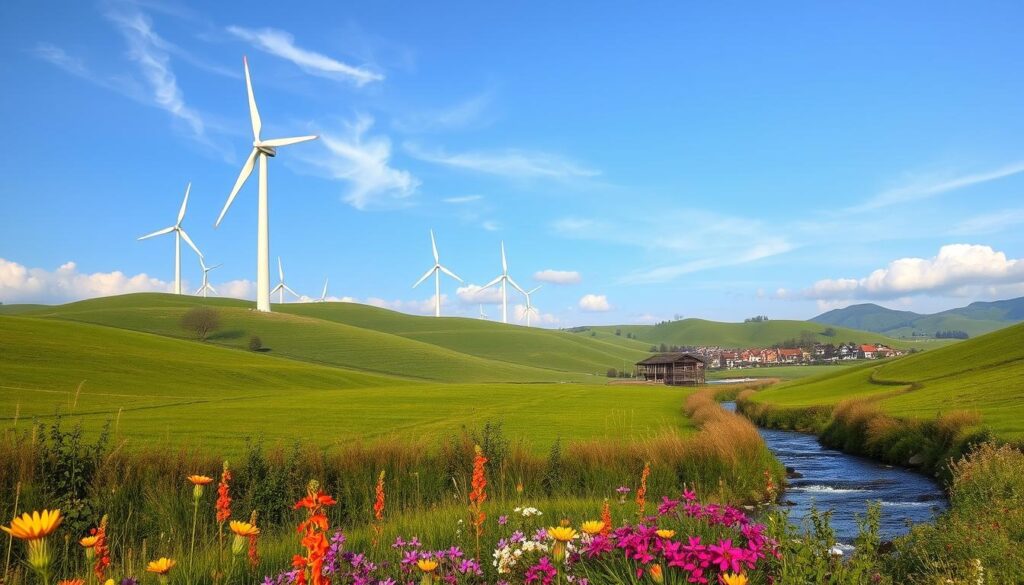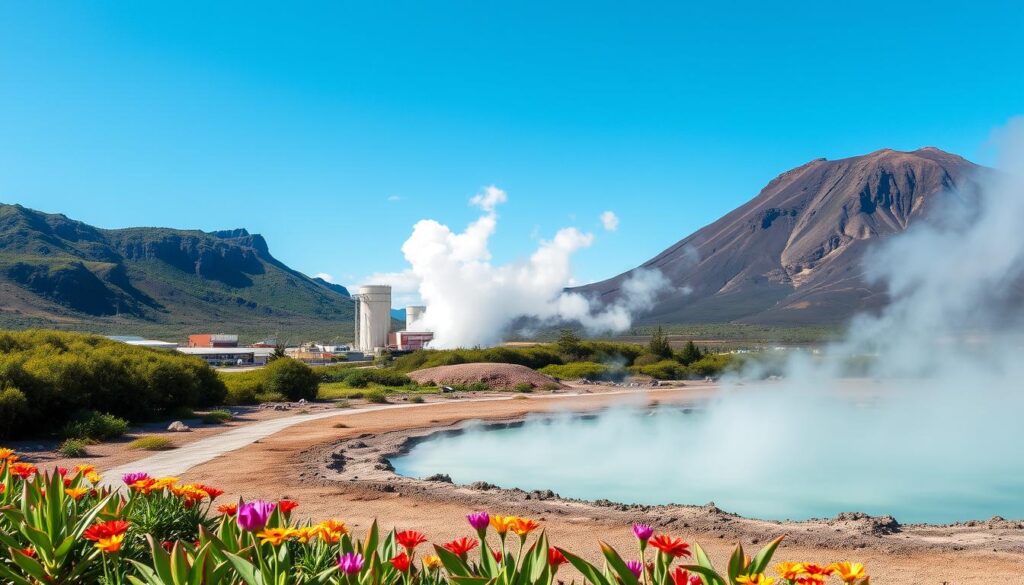Did you know the global renewable energy market is set to hit $1.9 trillion by 2030? This huge growth shows we need sustainable solutions fast. We all can help start the clean energy movement. Together, we can make a greener future for everyone.
This article will dive into how green tech and renewable energy can change our world. We’ll look at their history, important moments, and today’s eco-friendly breakthroughs. You’ll learn about clean energy types like solar, wind, geothermal, and biomass. We’ll also see how using these can help our planet and wallets.

Table of Contents: Green Technology and Renewable Energy
Key Takeaways
- The global renewable energy market is expected to reach $1.9 trillion by 2030, signaling the urgency for sustainable solutions.
- Explore the evolution of green technology and renewable energy, from historical development to modern eco-friendly innovations.
- Discover the fundamentals of clean energy sources, including solar, wind, geothermal, and biomass.
- Understand the economic and environmental benefits of widespread renewable energy adoption.
- Recognize the role of individuals in driving the clean energy revolution and shaping a sustainable future.
The Evolution of Green Technology and Renewable Energy
The journey to a sustainable future has been exciting and full of change. Green technology and renewable energy have evolved a lot. Let’s look at how these changes have helped us move towards a greener world.
Historical Development of Sustainable Solutions
Green technology started in the early 20th century. People then saw the need for cleaner energy because of fossil fuels’ harm. Innovations in solar, wind, and geothermal energy began our journey to a cleaner future.
Key Milestones in Clean Energy Innovation
- 1970s Oil Crisis: Sparked initial renewable energy research
- 1990s: Technological efficiency improvements
- 2000-2010: Solar panel cost reduction by 89%
- 2010-2020: Wind energy becomes cost-competitive with fossil fuels
- 2020-2024: Breakthrough in energy storage technologies
The Path to Modern Eco-friendly Technologies
The need for clean energy keeps growing. Green tech and renewable energy have changed a lot. Now, we have better energy storage and smart energy systems. The future looks very promising.
| Green Technology | Renewable Energy | Sustainable Solutions |
|---|---|---|
| Solar power | Wind energy | Geothermal power |
| Biofuels | Hydropower | Waste-to-energy |
| Energy-efficient buildings | Tidal and wave power | Smart grid technology |
As we keep exploring green tech and renewable energy, the future looks bright. From old breakthroughs to today’s innovations, we’re moving towards a better tomorrow.
Understanding the Fundamentals of Clean Energy Sources
The world is moving towards a sustainable future. It’s key to know about clean energy sources. Clean energy, or renewable energy, comes from natural resources that are endless and don’t harm the environment much. Sources like solar, wind, geothermal, and biomass are leading us to a cleaner, healthier planet.
Clean energy is great because it’s renewable. Unlike fossil fuels, which run out, these sources can be used forever. They give reliable power to homes, businesses, and communities.
| Clean Energy Source | Renewable Nature | Environmental Impact |
|---|---|---|
| Solar | Unlimited supply of sunlight | Minimal carbon emissions |
| Wind | Perpetual wind patterns | No direct greenhouse gas emissions |
| Geothermal | Continuous heat from the Earth’s core | Negligible air and water pollution |
| Biomass | Regenerative organic materials | CO2-neutral energy production |
Clean energy sources are also very efficient. They use more of the energy they make, wasting less. As technology gets better, clean energy will get even cheaper and more efficient.
“Renewable energy sources are the future of energy production, giving us a sustainable and eco-friendly choice instead of fossil fuels. By choosing clean energy, we help make our planet healthier and our energy use more efficient.”
Learning about clean energy helps you make better choices about energy. It’s a step towards a cleaner, more sustainable world.

Solar Power: Harnessing the Sun’s Unlimited Potencial
The world is moving away from fossil fuels and towards renewable energy. Solar power is leading the way. It turns the sun’s endless energy into clean electricity for our homes, businesses, and communities.
Photovoltaic Technology Advancements
Photovoltaic (PV) technology is at the core of solar power. It has seen big improvements in recent years. Better solar cells, panel designs, and tracking systems have made solar power more efficient and affordable.
Current Technological Advancements
- Efficiency Rates: Modern solar panels reach 22-25% efficiency
- Cost Trends:
- 2010: $7.50 per watt
- 2024: $2.50 per watt
- Storage Solutions:
- Lithium-ion battery improvements
- Emerging solid-state battery technologies
Solar Storage Solutions
Storing solar power for when the sun isn’t out has been a big challenge. But, the solar industry has made huge progress. Now, we have advanced batteries and hybrid systems that store and use solar energy well.
Residential and Commercial Applications
Solar power is no longer just for big farms. Homeowners and businesses are using it too. Rooftop panels let people make their own clean energy. Big facilities are also using solar to be more green and efficient.
The solar power industry is growing fast. With better tech, storage solutions, and more use, solar power is key to a clean energy future.

| Technology | Efficiency | Cost | Applications |
|---|---|---|---|
| Monocrystalline Solar Panels | 16-22% | High | Residential, Commercial |
| Polycrystalline Solar Panels | 14-18% | Moderate | Residential, Commercial |
| Thin-Film Solar Panels | 10-16% | Low | Utility-scale, Building-integrated |
| Concentrated Solar Power | 15-25% | High | Utility-scale |
The table shows different solar power technologies. It compares their efficiency, cost, and uses. As the solar industry grows, these options are getting better and more affordable. This is helping solar power, renewable energy, and energy efficiency become more popular.
Wind Energy: Powering Tomorrow’s Communities
The world is moving towards renewable energy, and wind power is leading the way. This clean energy is changing how we power our homes, businesses, and communities.
Economic and Technological Insights
- Global Installed Capacity:
- 2020: 743 GW
- Projected 2030: 1,500 GW
- Job Creation:
- Wind sector employment: 1.2 million jobs worldwide
- Projected growth: 3.7 million jobs by 2030
Wind power growth is impressive. Onshore wind farms with tall turbines are common in the U.S. Offshore wind projects, using strong winds over water, are also growing fast.
Wind power does more than just make electricity. It boosts local economies by creating jobs in manufacturing, installation, and maintenance. Communities with wind energy see new businesses and economic growth.
Wind energy changes how we view energy. It helps us use less fossil fuels and more wind power. The clean energy movement is strong, and wind power is at the forefront. It’s powering our communities and creating a better future.
“The wind is a free and clean energy source, and it’s one of our most abundant renewable resources.” – Kristina Johnson, former U.S. Department of Energy Undersecretary

Geothermal Power: Earth’s Natural Heat Resource
Underneath our feet, a huge, untapped energy source waits: geothermal power. It uses the Earth’s natural heat, a clean and reliable choice instead of fossil fuels. As we move towards a greener world, knowing about geothermal energy is key.
Deep Earth Energy Extraction
To get geothermal energy, we drill deep into the Earth. There, we find steam, hot water, and rock. These are used to make electricity or heat and cool buildings.
New drilling tech and better ways to find these resources have made it cheaper and more efficient. This opens the door for more people to use geothermal energy.
Residential Geothermal Systems
Geothermal energy isn’t just for big plants; it works in homes too. Geothermal heat pumps use the ground or water to heat and cool. They’re very efficient, cutting down on energy use and emissions.
More people are choosing geothermal systems for their homes. It’s a step towards a more sustainable living.
Technological Breakthroughs
- Enhanced Geothermal Systems (EGS)
- Improved Drilling Technologies
- Efficiency Improvements:
- Current conversion rates: 10-20%
- Projected 2030 rates: 25-30%
Industrial Applications and Benefits
Geothermal power is also great for industries. It can power factories, provide heat for different industries, and help make minerals from geothermal fluids. Using the Earth’s heat, industries can use less fossil fuels, cut carbon emissions, and help the economy grow sustainably.
Geothermal energy is a big hope for fighting climate change and a greener future. It offers clean, reliable power and works well for homes and industries. Geothermal power is key to a sustainable energy world.

Biomass Energy: Converting Waste to Power
Using biomass energy is key to a greener future. It turns waste into power, changing how we make electricity and heat.
Biomass energy uses organic stuff like plant waste and old wood. It turns these into fuels and gases, a clean alternative to fossil fuels.
Biomass energy is very useful. It can power homes, businesses, and communities. This cuts down on fossil fuel use and pollution.
New tech makes biomass energy better and cheaper. Things like advanced digestion and gasification help us use biomass more efficiently.
As we aim for a greener future, biomass energy is a big help. It’s good for the planet and helps manage waste. By using it, we move towards a cleaner energy world.
Conversion Technologies
- Anaerobic Digestion
- Gasification
- Pyrolysis
- Potential CO2 reduction: Up to 80% compared to fossil fuels
Biomass Conversion Technologies
There are many ways to turn biomass into energy. Let’s look at some:
- Combustion: Burning biomass to make heat and electricity.
- Gasification: Turning biomass into a gas for power or fuel.
- Anaerobic Digestion: Breaking down organic stuff without oxygen to make biogas.
- Pyrolysis: Heating biomass without oxygen to get bio-oil, biochar, and syngas.
| Technology | Conversion Process | Primary Energy Product |
|---|---|---|
| Combustion | Burning biomass materials | Heat, Electricity |
| Gasification | Thermal conversion of biomass into synthetic gas | Syngas |
| Anaerobic Digestion | Microbial breakdown of organic matter in the absence of oxygen | Biogas |
| Pyrolysis | Thermal decomposition of biomass in the absence of oxygen | Bio-oil, Biochar, Syngas |
These different ways to use biomass energy make it a flexible and strong renewable energy choice.
Smart Grid Technology and Energy Distribution
Smart grid technology is changing the game in energy distribution. It combines green technology, energy efficiency, and eco-friendly innovations. This makes powering our homes, businesses, and communities more efficient and sustainable.
Grid Modernization Initiatives
Governments and utility providers are working hard to modernize our energy grid. They’re upgrading old grids, installing new meters, and using digital tech to manage energy better. This makes our energy system more resilient, efficient, and green.
Digital Integration and Automation
Smart grid tech uses digital tools to improve how we use and distribute energy. It includes real-time monitoring, predictive analytics, and automated systems. These tools help us use energy smarter and more efficiently.
Consumer Benefits and Engagement
Smart grid tech benefits us by giving us more control over our energy use. We can see how much energy we use, join demand response programs, and even make our own renewable energy. This leads to a more sustainable and energy-efficient future.
“The smart grid is essential for integrating renewable energy and improving energy efficiency, ultimately leading to a cleaner and more sustainable energy future.”
Economic Impact of Renewable Energy Adoption
The world is moving towards renewable energy and it’s showing clear economic benefits. The clean energy sector is creating jobs and saving money for businesses and people. This is a big win for everyone.
The renewable energy industry is growing fast, creating many new jobs in the U.S. Jobs range from installing solar panels to fixing wind turbines. This growth is helping local economies a lot.
| Sector | Job Growth (2019-2029) |
|---|---|
| Solar Photovoltaic Installers | 51% (much faster than average) |
| Wind Turbine Service Technicians | 61% (much faster than average) |
| Geothermal Technicians | 17% (faster than average) |
There’s also a big plus in saving money with sustainable energy. People and businesses using solar panels, geothermal systems, and energy-saving appliances can cut their energy costs. This means more money in their pockets.
“The economic benefits of renewable energy go beyond just job creation. The long-term cost savings for businesses and consumers can be truly transformative.”
As the U.S. focuses on renewable energy, the economic benefits will keep growing. This will lead to a brighter, more sustainable future for all.
Environmental Benefits and Sustainability Goals
Using green technology and renewable energy does more than save money on bills. It also helps the planet a lot. By cutting down on carbon emissions, you help keep our ecosystems healthy and fight climate change. Your choices today can make the world better for future generations.
Carbon Footprint Reduction
Switching to clean energy like solar and wind cuts down on greenhouse gases. This helps fight global warming. Every bit of clean energy you use means less pollution from fossil fuels.
With new tech and energy-saving upgrades, you can make a big difference. You’ll leave a positive mark on the planet for years to come.
Ecosystem Preservation
Renewable energy helps keep our ecosystems in balance. Unlike old energy methods, it doesn’t harm habitats or wildlife. It works with nature, not against it.
By using the sun, wind, and earth, you protect our landscapes. You also help keep biodiversity strong. This means a healthier planet for all of us.
Climate Change Mitigation
Your choice to go green is key in fighting climate change. As more people use renewable energy, we use less fossil fuels. This cuts down on harmful emissions.
By choosing a sustainable energy path, you help make our world more resilient. It’s ready to face the challenges of a changing climate.
FAQ
What is the role of green technology and renewable energy in shaping a cleaner future?
Green technology and renewable energy are key to a sustainable future. They help us use clean energy sources. This way, we can protect our planet for future generations.
What are the major milestones in the evolution of green technology and renewable energy?
The journey of green technology and renewable energy has seen many milestones. From early sustainable solutions to modern eco-friendly technologies, it’s been a path of innovation. This journey has shaped our world.
How do different clean energy sources work and what are their benefits?
Clean energy sources like solar, wind, geothermal, and biomass are important. They work in unique ways, each with its own benefits. Understanding these can help us use energy more efficiently.
What advancements are driving the growth of solar power?
Solar power is growing fast, thanks to better photovoltaic tech and storage solutions. It’s being used more in homes and businesses. This growth shows the sun’s power is limitless.
How is wind energy shaping the future of clean power?
Wind power is a big part of the clean energy future. It’s powering communities with onshore and offshore wind farms. This growth is changing local economies and the environment.
What are the benefits of harnessing geothermal energy from the earth?
Geothermal power uses the earth’s heat for clean energy. It has many uses, from deep energy extraction to home systems. This renewable energy is key to sustainability.
How can biomass energy contribute to a circular economy?
Biomass energy turns waste into power, fitting the circular economy model. It uses various conversion technologies. This renewable energy is vital for sustainable waste management and energy.
What is the significance of smart grid technology in the future of energy distribution?
Smart grid tech is changing energy distribution and management. It uses digital solutions for a more efficient system. This shift is making energy distribution better and greener.
What are the economic benefits of transitioning to renewable energy?
Switching to renewable energy brings economic gains. It creates jobs in green tech and saves money in the long run. This shift can make our future more prosperous.
How do green technology and renewable energy contribute to environmental sustainability and climate change mitigation?
Green tech and renewable energy have big environmental benefits. They reduce carbon footprints and protect ecosystems. They help fight climate change, making our planet more sustainable.
Share this content:

